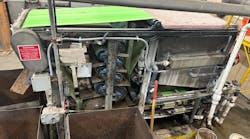The Broward County (Fla.) North Regional Wastewater Treatment Plant, located in Pompano Beach, Fla., is doubling their dewatering capacity from 900 gpm to 1800 gpm in order to meet county growth projections.
To accomplish this, they needed to install six additional belt filter presses, bringing their total to 12 units. Completion of this project will make the Broward County facility one of the five largest belt filter press dewatering facilities in the U.S.
Originally, the Broward County North Regional Wastewater Treatment Plant operated plate and frame presses and vacuum filters that used lime and ferric chloride to condition the sludge prior to dewatering. In 1991, three belt filter presses were installed. These three units performed well for over 13 years and are still in operation today.
The capacity of the dewatering facility was expanded in 2000 with the installation of three more identical belt presses. A temporary outdoor belt filter press facility was constructed to operate the new belt filter presses.
The current expansion phase, scheduled to be online in late 2004, includes the installation of six additional belt filter presses—for a total of 12 units. The six units are the exact same model as the current units and are provided by USFilter Dewatering Systems of Holland, Mich.
The USFilter Linear Wedge belt filter press was selected based on its good operational record and to maintain replacement part compatibility with the existing presses. Broward County Wastewater Treatment Plant Superintendent, Ralph Aliseo, said the operational reliability and ease of maintenance of the USFilter Linear Wedge belt filter press are the main reasons the county has decided to continue using the same model.
According to Aliseo, the 12 belt filter presses will each operate at a capacity of about 200 gpm with a feed solids concentration of 2–3% and will produce a dewatered cake of 16–18% total solids.
In the zones
The Linear Wedge belt filter press is designed for dewatering a wide variety of sludge types. The dewatering process is performed in three separate stages:
• the gravity zone;
• the wedge zone; and
• the high-pressure zone.
In the gravity zone, the free water is removed and the sludge is thickened. A series of plows is provided to compress and turn the sludge over thereby enhancing the release of water.
In the wedge zone (or low-pressure zone), the two belts converge and apply gradually increasing pressure; this zone features an adjustable upper grid to vary the pressure based on specific sludge characteristics.
The high-pressure zone subjects the semi dewatered sludge to gradually increasing pressure and shearing forces by conveying the cake over eight rollers of decreasing diameter; the first roller is perforated to increase filtration area.
The belt tension is obtained using a pneumatic air bellows system rather than a hydraulic tensioning system, eliminating the need for cylinders with high maintenance seals and o-rings.
Polymer and sludge mixing is accomplished with a floc tank and variable speed agitator prior to the belt press.
This system has been found to reduce polymer consumption and improve floc stability by providing a rapid mix zone in the bottom of the tank and then up to 60 seconds of reaction time prior to being discharged onto the belt.
According to Ghislaine Carr, project manager with Hazen and Sawyer, P.C., “The latest purchase of six USFilter belt filter presses are part of a plant expansion that will bring the plant’s capacity to 100 mgd. The six new presses will be installed in a dewatering building constructed under this expansion. The three presses purchased in 2000 will be relocated in the new dewatering facility.
“The anaerobically digested sludge will be pumped to the dewatering building, and dewatered solids will be hauled away and land applied. The plant will operate nine units, with the original three units remaining for backup at this time,” added Carr. “Three additional machines may be installed in the future in the new dewatering facility, as the county intends to consolidate all dewatering operations at a single location.” Plant Superintendent Aliseo added that the Broward County facility plans to operate the belt filter press for 16 to 20 hours a day, six to seven days a week.
“The press is very durable and operator friendly,” said Aliseo. “The O&M is low, other than basic preventative maintenance and belt changes.”
The plant has the units set up to operate in an automatic polymer feed mode.

